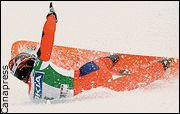

|
|
Public Health
 Epidemiology: The popularity of snowboarding has grown tremendously since the sport was introduced commercially 20 years ago. This winter, 20% to 30% of all visitors to North American ski resorts will be snowboarders.1 In the 1980s, the typical snowboarder was a 19-year-old male attracted to the sport by its relatively low cost, baggy pants, goofy hats and the thrill of "catching air" during aerial manoeuvres. Today the sport is enjoyed by children as young as 4 and seniors in their 60s, and about 25% of snowboarders are female.2,3 As the demographic profile of snowboarders evolves, so will the patterns of their injuries.
Epidemiology: The popularity of snowboarding has grown tremendously since the sport was introduced commercially 20 years ago. This winter, 20% to 30% of all visitors to North American ski resorts will be snowboarders.1 In the 1980s, the typical snowboarder was a 19-year-old male attracted to the sport by its relatively low cost, baggy pants, goofy hats and the thrill of "catching air" during aerial manoeuvres. Today the sport is enjoyed by children as young as 4 and seniors in their 60s, and about 25% of snowboarders are female.2,3 As the demographic profile of snowboarders evolves, so will the patterns of their injuries.
Estimates of the risk of snowboarding-related injuries, based on the number of injured patients presenting to local hospitals in relation to the number of lift tickets sold, range between 1.7 and 16 injuries per 1000 days of snowboarding.3 According to several reported case series, 80% of injured snowboarders are male, with a median age of 20 years.4,5 Novices are at greatest risk, with almost 25% of injuries occurring during a person's first experience and almost 50% occurring during the first season.1,4 Most injuries are caused by direct impact during falls or while attempting jumps,5 with torsion and collision playing less of a role than in skiing injuries. Clinical management: Knowing the type of equipment used and the rider's position on the board is important in evaluating injuries. Unlike skiers, snowboarders stand perpendicular to the long axis of their boards, with both feet affixed by nonreleasable binders to a single board. They most often face rightward, using the left leg and hand to lead the ride downhill and placing the bulk of the body's weight on the right rear leg.1 As with surfers and skateboarders, arms and hands remain free and are used for balance. Most recreational snowboarders wear soft boots, which allow for maximum comfort and manoeuvrability. Hard boots provide greater ankle support and increased control and are worn primarily by racers. Hybrid boots, which combine a hard shell with a soft upper component, provide a balance between manoeuvrability and stability and are becoming increasingly popular. Since each boot style places the body under different stresses, it is important to enquire about the type of boot worn when injuries are being evaluated.6 Because of the fixed position of the lower limbs, snowboarders tend to use the outstretched arm to break a fall. Wrist injuries due to falls onto a hyperextended wrist account for almost half of all snowboarding-related injuries.3,7 Most of these (50%–65%) are fractures,2 so evaluation of a wrist with point tenderness should include radiology studies. Wrist guards appear to decrease the risk of wrist injury but may place the areas proximate to the device, such as the fingers, radial shaft and shoulder, under greater stress.4 Ankles are involved in 12%–17% of snowboarding-related injuries.6,7 Physicians need to be alert to the possibility of a fracture to the lateral process of the talus, known as "snowboarder's ankle," because it accounts for as many as one-third of ankle fractures in this population.6 The mechanism is a forcing of the ankle into dorsiflexion and inversion during a landing from an aerial manoeuvre, especially when the landing has been over-rotated. This fracture is difficult to see on a standard ankle x-ray series and requires CT scanning for definitive diagnosis. Surgical repair is required, with excision of fracture fragments or internal fixation of the fractures.7 Because snowboarders often fall backward, blows to the back of the head account for about 12% of injuries. Fortunately, force load on the head is usually mild, with most of the force being absorbed by the buttocks, back and upper extremities. However, this may result in vertebral column fracture, a diagnosis reported in 11% of the snowboarding-related injuries evaluated in a recent case series.5 Prevention: A survey of 355 injured snowboarders revealed that only 6% wore wrist guards, 14% used kneepads and 3% used elbow pads.4 Only 1% of children treated and released from an emergency department for snow-related recreational injuries reported wearing a helmet.8 According to cross-sectional data, failure to wear a wrist guard increases the risk of wrist injury 2.78 times.3 However, the effectiveness of snowboarding safety devices has not been well evaluated, and further research and development of safety equipment is needed. Current recommendations to lessen the risk of injury, particularly among novices, include formal training in proper snowboarding techniques, using soft-shell boots with a stiff inner boot for ankle support and wearing helmets, padding and wrist guards.5 A recent article provides a thorough survey of the issue.9 — Erica Weir, CMAJ References
Copyright 2001 Canadian Medical Association or its licensors |